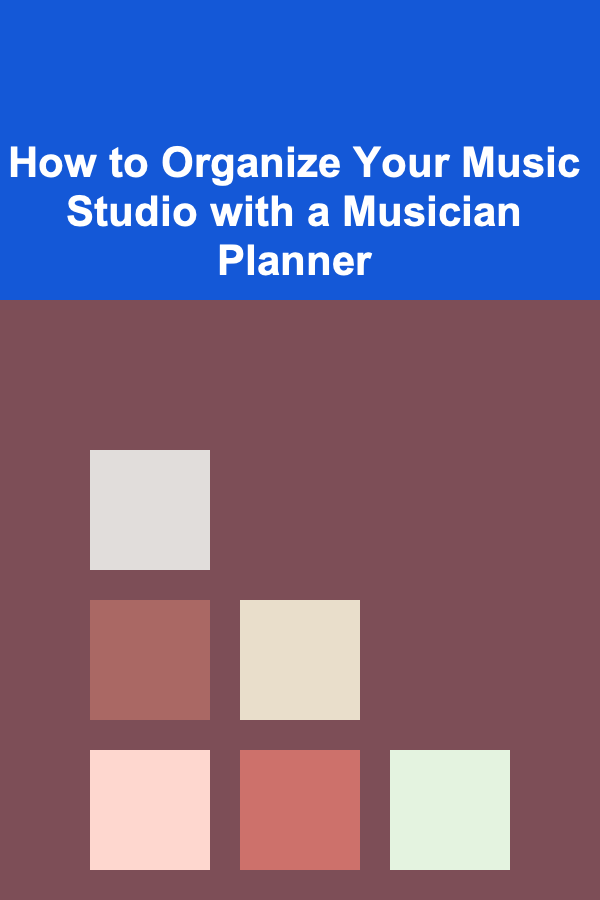
How to Organize Your Music Studio with a Musician Planner
ebook include PDF & Audio bundle (Micro Guide)
$12.99$9.99
Limited Time Offer! Order within the next:

Creating an organized and efficient music studio is essential for any musician or producer. Whether you're a hobbyist, a professional musician, or a music producer, maintaining an organized workspace can significantly enhance your productivity and creativity. A well-organized music studio allows you to focus on your music rather than wasting time looking for gear, sheet music, or software tools.
A key component of an organized music studio is having a solid plan. This is where a musician planner comes into play. A musician planner is a tool that can help you structure your time, manage projects, track goals, and ensure that all your tasks and resources are in order. In this article, we'll explore how you can organize your music studio with the help of a musician planner, turning your creative space into a hub of productivity and inspiration.
What Is a Musician Planner?
A musician planner is a specialized organizational tool designed to help musicians, composers, and producers stay on top of their music-related tasks. While traditional planners can be useful for any professional, musician planners are tailored to address the unique needs of musicians. These planners often include sections for scheduling practice sessions, managing projects, tracking music releases, planning tours or performances, and more.
Here's how a musician planner can benefit you:
- Task Management: Keep track of your daily, weekly, and long-term music-related tasks, such as composing, recording, mixing, and practicing.
- Project Organization: Stay organized by managing multiple projects, ensuring that deadlines are met, and that each step of a project is completed in a timely manner.
- Goal Setting: Set specific music-related goals, whether it's finishing an album, learning a new instrument, or improving technical skills.
- Resource Management: Keep track of gear, software, and other resources in your studio, ensuring that everything is in place and well-maintained.
With a musician planner, you'll be able to turn your chaotic studio space into a productive and creative environment.
The Benefits of Using a Musician Planner in Your Studio
1. Enhanced Time Management
Time is a precious commodity in a musician's life, and it's easy to lose track of hours when you're in the creative zone. A musician planner helps you schedule your time efficiently, ensuring that you're dedicating time to important tasks like practicing, composing, recording, or even collaborating with other musicians. It will help you prioritize your time, set reminders for deadlines, and block out time for rest and relaxation, ensuring that you're not overworking yourself.
Example:
- Weekly Schedule: Set aside specific days or hours for different activities, such as songwriting on Mondays, practicing instrument technique on Tuesdays, and recording or mixing on Wednesdays.
2. Better Focus on Goals
A planner can help you break down large projects or long-term goals into manageable steps. For example, instead of saying "finish album," you can break this down into smaller tasks like writing lyrics, composing melodies, recording vocals, mixing, and mastering. By focusing on these smaller tasks, you make steady progress, and the goal becomes less overwhelming.
Example:
- Monthly Goals: Set concrete goals, such as writing 10 new songs or recording the first half of your album. Review these goals at the end of each month and adjust them as necessary.
3. Track Progress
By using a planner, you can visually track your progress. Whether you are marking off completed tasks or writing reflections on your creative process, tracking progress helps you stay motivated and see how far you've come. Additionally, it enables you to identify where you might be falling behind and adjust your schedule accordingly.
Example:
- Task Completion Checklists: Use checklists for every project, ticking off items as they are completed. You'll feel accomplished as you see the tasks disappear.
4. Creative Inspiration and Routine Balance
It's easy to get caught in a cycle of routine that stifles creativity. A good musician planner can help strike a balance between structure and freedom. You can schedule time for creativity and allow yourself to experiment with new ideas, while also making sure that you're meeting deadlines and staying on track with your projects.
Example:
- Dedicated Creative Time: Block out time for free experimentation without the pressure of deadlines, helping you refresh your creativity.
Step-by-Step Guide to Organizing Your Music Studio with a Musician Planner
Step 1: Set Up Your Studio Space
Before you start using a musician planner to organize your workflow, it's essential to have a clean and functional music studio space. Here are some tips for organizing your physical space:
- Declutter Your Studio: Clear out unnecessary items, and create a clean environment. Ensure your equipment is easily accessible, and all cables, instruments, and gear are organized.
- Label Everything: Use labels to mark important equipment, gear, and storage areas so that you can quickly locate what you need.
- Create a Functional Layout: Arrange your desk, instruments, and other equipment in a way that makes sense for your workflow. This might mean placing your computer, MIDI keyboard, and mixing console within easy reach.
Once your studio is set up, move on to the planner.
Step 2: Choose the Right Musician Planner
There are many types of planners available, from physical notebooks to digital tools. Some musicians prefer the tactile experience of writing in a physical planner, while others opt for digital planners that allow for easy updates and integration with other tools.
When choosing a musician planner, consider the following:
- Format: Would you prefer a physical planner or a digital version? Physical planners are great for hands-on interaction, while digital planners are more flexible and accessible from anywhere.
- Customizability: Choose a planner that allows you to add specific sections related to your work as a musician (e.g., sections for song ideas, practice schedules, or recording timelines).
- Goal-Oriented Design: Make sure the planner has space for goal setting, project tracking, and performance scheduling.
Example:
- If you prefer paper planners, look for a customizable planner like the "Moleskine Musician's Journal" or "The Musician's Planner."
- For digital planners, apps like Notion, Todoist, or Trello are highly adaptable and can be tailored to your needs.
Step 3: Create a Daily/Weekly Schedule
With your planner in hand, start by organizing your time. As a musician, your schedule might vary from day to day depending on your projects, collaborations, and other commitments. However, having a general structure will help you stay on track.
- Daily Tasks: Set specific tasks for each day, such as practicing scales, writing lyrics, or recording vocals.
- Weekly Overview: Write down your most important tasks for the week, such as a recording session or a rehearsal with a band.
- Prioritize Tasks: Not everything needs to be done at once. Prioritize your tasks so that you are always focusing on the most important thing first.
Example:
- Monday: Songwriting from 10 AM to 2 PM, practice guitar from 3 PM to 5 PM.
- Tuesday: Recording session at the studio from 9 AM to 6 PM.
Step 4: Track Your Projects
A musician planner is invaluable when managing multiple projects, whether it's an album, a single release, or a live performance. Use the planner to track the progress of each project, breaking it down into actionable tasks.
Example:
- Album Project :
- Songwriting: Write the lyrics and melodies for three songs by the end of the month.
- Recording: Schedule studio time for vocals and instruments.
- Mixing: Set a deadline for mixing tracks.
By breaking projects down into smaller steps, you can ensure that you're making consistent progress and not overlooking any important tasks.
Step 5: Set and Review Goals Regularly
Your planner should be a space for goal setting. Whether you're learning a new instrument, improving your production skills, or releasing music, setting clear goals will keep you focused and motivated.
Example:
- Short-Term Goals: Record three demo tracks by the end of the month.
- Long-Term Goals: Complete and release a full album within six months.
At the end of each week or month, take time to reflect on your progress. Did you meet your goals? If not, what can you adjust moving forward? Regularly reviewing your goals will keep you on track and ensure that you're progressing in the right direction.
Step 6: Organize Resources and Equipment
Keep track of your gear, software, and other resources. A section of your planner should be dedicated to managing your studio resources, including:
- Inventory: Keep a list of all your equipment and software, noting any maintenance or upgrades that might be needed.
- Tech Support: Jot down tech issues, solutions, and contacts for future reference.
- Software Updates: Track software versions and updates that are important to your workflow.
Having all of this information in one place will ensure that you're always prepared and that your studio functions smoothly.
Conclusion
Organizing your music studio with a musician planner is a highly effective way to stay on top of your tasks, projects, and goals. By creating a structured workflow, managing your time, and keeping track of your resources, you'll enhance your productivity, reduce stress, and ensure that your creative process remains fluid and inspiring. Whether you're a seasoned professional or an aspiring musician, a musician planner can be a game changer for maintaining focus, achieving your goals, and ultimately succeeding in the music industry.
Reading More From Our Other Websites
- [Home Pet Care 101] How to Make Homemade Pet Treats Your Furry Friend Will Love
- [Organization Tip 101] How to Keep Guests Informed with an Updated Itinerary
- [Mindful Eating Tip 101] Best Mindful Eating Techniques for Managing Emotional Overeating in Teens
- [Home Family Activity 101] How to Plan a Family DIY Spa Night
- [Survival Kit 101] Emergency Radio: The Ultimate Guide to Choosing the Best Radio for Crisis Situations
- [Home Holiday Decoration 101] How to Install Christmas Lights: Tips for a Beautiful and Safe Display
- [Home Storage Solution 101] How to Use Baskets and Bins for Hidden Storage Solutions
- [Organization Tip 101] How to Organize Supplies and Tools in Your Garage Inventory
- [Home Renovating 101] How to Renovate Your Home on a Tight Budget
- [Personal Care Tips 101] How to Prevent Cuticle Damage with Regular Oil Application

How To Protect Your Brain from Environmental Pollution
Read More
The Pros and Cons of One-Page Websites: Is It Right for You?
Read More
Unlock the Secrets of Effective Account Management
Read More
How to Understand the Apollo Missions
Read More
How to Foster Innovation Within Your Team
Read More
How to Design Earthquake-Resistant Steel Structures
Read MoreOther Products

How To Protect Your Brain from Environmental Pollution
Read More
The Pros and Cons of One-Page Websites: Is It Right for You?
Read More
Unlock the Secrets of Effective Account Management
Read More
How to Understand the Apollo Missions
Read More
How to Foster Innovation Within Your Team
Read More